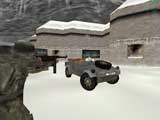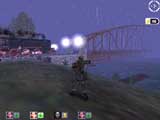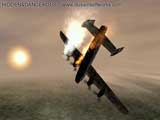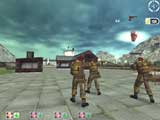 Yes, the PC to DC game
conversion is in stride. Recently making the jump: Hidden and Dangerous, a tactical sim
that taps into the fascination America has with World War II. The result is a healthy mix
of strategy and action, articulated gameplay and pure frustration.
Yes, the PC to DC game
conversion is in stride. Recently making the jump: Hidden and Dangerous, a tactical sim
that taps into the fascination America has with World War II. The result is a healthy mix
of strategy and action, articulated gameplay and pure frustration.Hidden and Dangerous
lets you control a crack team of SAS operatives. Armed only with what they can carry or
steal, your four men must maneuver deep within enemy lines, rescue fellow service men,
sabotage enemy equipment, and eliminate all hostiles. But these missions are not carried
out on a whim. You must orchestrate a strategic campaign to ensure success. Without a
solid plan of action, your men may be doomed before they step onto the battlefield.
 This
game is an incredible amalgam of styles and concepts. It is a complex and demanding
strategy game as well as a guts and glory action game. You toggle between menus, maps,
soldiers, and points-of-view (1st-, 3rd-, and 3rd-person
distant). You can swap, drop, and steal weapons and supplies. In later missions you can
change your camouflage, dress as civilians, even adopt the uniform of the enemy to better
infiltrate your target. You can pile your men into classic WWII vehicles such as Panzer
tanks, gunboats, even an Avro Lancaster bomber. And they pull most of this off fairly
well.
This
game is an incredible amalgam of styles and concepts. It is a complex and demanding
strategy game as well as a guts and glory action game. You toggle between menus, maps,
soldiers, and points-of-view (1st-, 3rd-, and 3rd-person
distant). You can swap, drop, and steal weapons and supplies. In later missions you can
change your camouflage, dress as civilians, even adopt the uniform of the enemy to better
infiltrate your target. You can pile your men into classic WWII vehicles such as Panzer
tanks, gunboats, even an Avro Lancaster bomber. And they pull most of this off fairly
well.
 The graphics are
top-notch in terms of image rendering and texture. Even under the cover of darkness and in
the rain everything is crisp and convincing. And I love those tracer bullets. However, the
game does have serious clipping problems and sporadic glitches. You eventually resign
yourself to seeing only half of the characters when they stand next to a tree, or wall, or
each other.
The graphics are
top-notch in terms of image rendering and texture. Even under the cover of darkness and in
the rain everything is crisp and convincing. And I love those tracer bullets. However, the
game does have serious clipping problems and sporadic glitches. You eventually resign
yourself to seeing only half of the characters when they stand next to a tree, or wall, or
each other.
 Overall, the game
presentation is awesome. Dynamic load screen art, official file work-ups, and astutely
technical click-and-draw 3D maps further your immersion into the theater and generally
provide a great war-groove. Plus it has one of the most inspiring soundtracks I have heard
in a war game since Return Fire.
Overall, the game
presentation is awesome. Dynamic load screen art, official file work-ups, and astutely
technical click-and-draw 3D maps further your immersion into the theater and generally
provide a great war-groove. Plus it has one of the most inspiring soundtracks I have heard
in a war game since Return Fire.
 The transition
from keyboard to controller is better than you might expect and makes me optimistic about
the other PC games that are in the works. Hidden and Dangerous utilizes each button on the
DC controller twice by designating the left trigger as a function button of sorts. It is
quite intuitive. Some issues that come up are limitations with the function button itself
as using the overlapping functions force you to pause and change up, making the kind of
uninterrupted movement you find in other games impossible. If you want the PC style
control you can use the DC keyboard. This will eliminate the overlapping buttons, but as
there is no DC mouse to date, it also eliminates the ability to look freely around your
character unless you use the analog joystick in tandem, and then again you have your
headaches.
The transition
from keyboard to controller is better than you might expect and makes me optimistic about
the other PC games that are in the works. Hidden and Dangerous utilizes each button on the
DC controller twice by designating the left trigger as a function button of sorts. It is
quite intuitive. Some issues that come up are limitations with the function button itself
as using the overlapping functions force you to pause and change up, making the kind of
uninterrupted movement you find in other games impossible. If you want the PC style
control you can use the DC keyboard. This will eliminate the overlapping buttons, but as
there is no DC mouse to date, it also eliminates the ability to look freely around your
character unless you use the analog joystick in tandem, and then again you have your
headaches.
 In terms of
gameplay, the strategy component is handled very well. You chose your campaign and the
mission specifics are then presented to you. Then, from a list of forty characters, you
chose eight to form your team, four for the mission. Characters are ranked according to
strength, endurance, stealth, reaction time, and accuracy when shooting. You supply them
with what they will need, according to what they can carry. Or forgo all of that and let
the computer set you up. This is good for beginners, as there is no way to fully
comprehend the ramifications of your choices until you have a little experience under your
belt. From there you enter the game and begin to lay out your strategy. This is the
point-and-click part. It is also the key to the game. By assigning and linking orders such
as Move, Follow, Use, Use Inventory, Attack, Guard, and Wait, you can dictate a great deal
of your team’s actions in detail, barring unforeseen developments, in which case you
can augment or interrupt their assignments. With the right strategy your unit can function
with deadly precision.
In terms of
gameplay, the strategy component is handled very well. You chose your campaign and the
mission specifics are then presented to you. Then, from a list of forty characters, you
chose eight to form your team, four for the mission. Characters are ranked according to
strength, endurance, stealth, reaction time, and accuracy when shooting. You supply them
with what they will need, according to what they can carry. Or forgo all of that and let
the computer set you up. This is good for beginners, as there is no way to fully
comprehend the ramifications of your choices until you have a little experience under your
belt. From there you enter the game and begin to lay out your strategy. This is the
point-and-click part. It is also the key to the game. By assigning and linking orders such
as Move, Follow, Use, Use Inventory, Attack, Guard, and Wait, you can dictate a great deal
of your team’s actions in detail, barring unforeseen developments, in which case you
can augment or interrupt their assignments. With the right strategy your unit can function
with deadly precision.
 Once all of
that is done, you enter the action component of the game, which, quite honestly, is one of
the single most frustrating experiences I have had in a long time. If you choose play
without strict assignments, or if your strategy unravels and you need to regroup, you can
use real-time commands—"follow me," "move on," "hold
fire," and the like—to go it off-the-cuff. And suddenly your precise and deadly
unit begins to resemble "Three Stooges on Ice." It is hard to believe they are
even the same people. They stumble and bumble around you, never holding still, colliding
with you and each other constantly. They knock you off course, off of ladders, into death
traps. When you lay down to crawl or hide, it is not uncommon for one of your teammates
walk up and lay down right on top of you, forcing you to spend valuable time and energy
trying to move, stand, or get them the hell off of you. And remember that "hold
fire" command, otherwise they will open fire whenever they see an enemy—even if
you are standing directly in their line of fire. Yes, their ineptitude goes so far as to
kill their own teammates. It comes down to pre- and in-game commands. Give them an
assignment and they are almost masterful. So much so that they sometimes seem predestined
to complete a sound plan. But their improvisational and cooperative skills are terrible.
And in close quarters, God help you. This points to lousy AI, and, dare I say, poor
programming. I don’t know what’s more frustrating—the fact that this one
component of the game is so inept, or that it undermines what was otherwise such a solid
game.
Once all of
that is done, you enter the action component of the game, which, quite honestly, is one of
the single most frustrating experiences I have had in a long time. If you choose play
without strict assignments, or if your strategy unravels and you need to regroup, you can
use real-time commands—"follow me," "move on," "hold
fire," and the like—to go it off-the-cuff. And suddenly your precise and deadly
unit begins to resemble "Three Stooges on Ice." It is hard to believe they are
even the same people. They stumble and bumble around you, never holding still, colliding
with you and each other constantly. They knock you off course, off of ladders, into death
traps. When you lay down to crawl or hide, it is not uncommon for one of your teammates
walk up and lay down right on top of you, forcing you to spend valuable time and energy
trying to move, stand, or get them the hell off of you. And remember that "hold
fire" command, otherwise they will open fire whenever they see an enemy—even if
you are standing directly in their line of fire. Yes, their ineptitude goes so far as to
kill their own teammates. It comes down to pre- and in-game commands. Give them an
assignment and they are almost masterful. So much so that they sometimes seem predestined
to complete a sound plan. But their improvisational and cooperative skills are terrible.
And in close quarters, God help you. This points to lousy AI, and, dare I say, poor
programming. I don’t know what’s more frustrating—the fact that this one
component of the game is so inept, or that it undermines what was otherwise such a solid
game.
 This is a
game with a steep learning curve. This might have been lessened had it incorporated a more
gradual advancement of tactical necessity between each level. For instance, you can fumble
your way through the first level with no strategy whatsoever, wasting ammo and time, lose
all but one of your team, and still succeed, but you won’t last a minute in the
second level without an advanced coordinated effort. Either way, though, if I am to give a
timely review I cannot possibly complete every aspect of the game. I haven’t gotten
to the point where I can fly the bomber yet, but I am sure it is something else. I have to
admit I hated this game at first. Like a stereotypical hardheaded console gamer, I began
without reading the booklet, without a strategy, and without a clue. My men followed me
blindly, killing each other, getting hit by trains, etc. But the more I play, the more I
like it. The frustration never goes away, but you learn to deal with it, work with the
game on its level. And the strategy side is compelling, addictive even. I cannot in good
conscience recommend this game, given the level of patience and tolerance it requires. But
if you are a WWII buff, or just intrigued by the concept, rent it. See if it hooks you.
This is a
game with a steep learning curve. This might have been lessened had it incorporated a more
gradual advancement of tactical necessity between each level. For instance, you can fumble
your way through the first level with no strategy whatsoever, wasting ammo and time, lose
all but one of your team, and still succeed, but you won’t last a minute in the
second level without an advanced coordinated effort. Either way, though, if I am to give a
timely review I cannot possibly complete every aspect of the game. I haven’t gotten
to the point where I can fly the bomber yet, but I am sure it is something else. I have to
admit I hated this game at first. Like a stereotypical hardheaded console gamer, I began
without reading the booklet, without a strategy, and without a clue. My men followed me
blindly, killing each other, getting hit by trains, etc. But the more I play, the more I
like it. The frustration never goes away, but you learn to deal with it, work with the
game on its level. And the strategy side is compelling, addictive even. I cannot in good
conscience recommend this game, given the level of patience and tolerance it requires. But
if you are a WWII buff, or just intrigued by the concept, rent it. See if it hooks you.
 On a final note, I would like to state my appreciation for the historical bio
of the SAS (Special Air Service) given in the opening pages of the booklet. Though there
are no cited sources, it is very specific and very informative. It is this kind of
attention to detail that gets the player involved with the game before he or she even
turns it on, and the experience is the better for it.
On a final note, I would like to state my appreciation for the historical bio
of the SAS (Special Air Service) given in the opening pages of the booklet. Though there
are no cited sources, it is very specific and very informative. It is this kind of
attention to detail that gets the player involved with the game before he or she even
turns it on, and the experience is the better for it.

 Yes, the PC to DC game
conversion is in stride. Recently making the jump: Hidden and Dangerous, a tactical sim
that taps into the fascination America has with World War II. The result is a healthy mix
of strategy and action, articulated gameplay and pure frustration.
Yes, the PC to DC game
conversion is in stride. Recently making the jump: Hidden and Dangerous, a tactical sim
that taps into the fascination America has with World War II. The result is a healthy mix
of strategy and action, articulated gameplay and pure frustration.